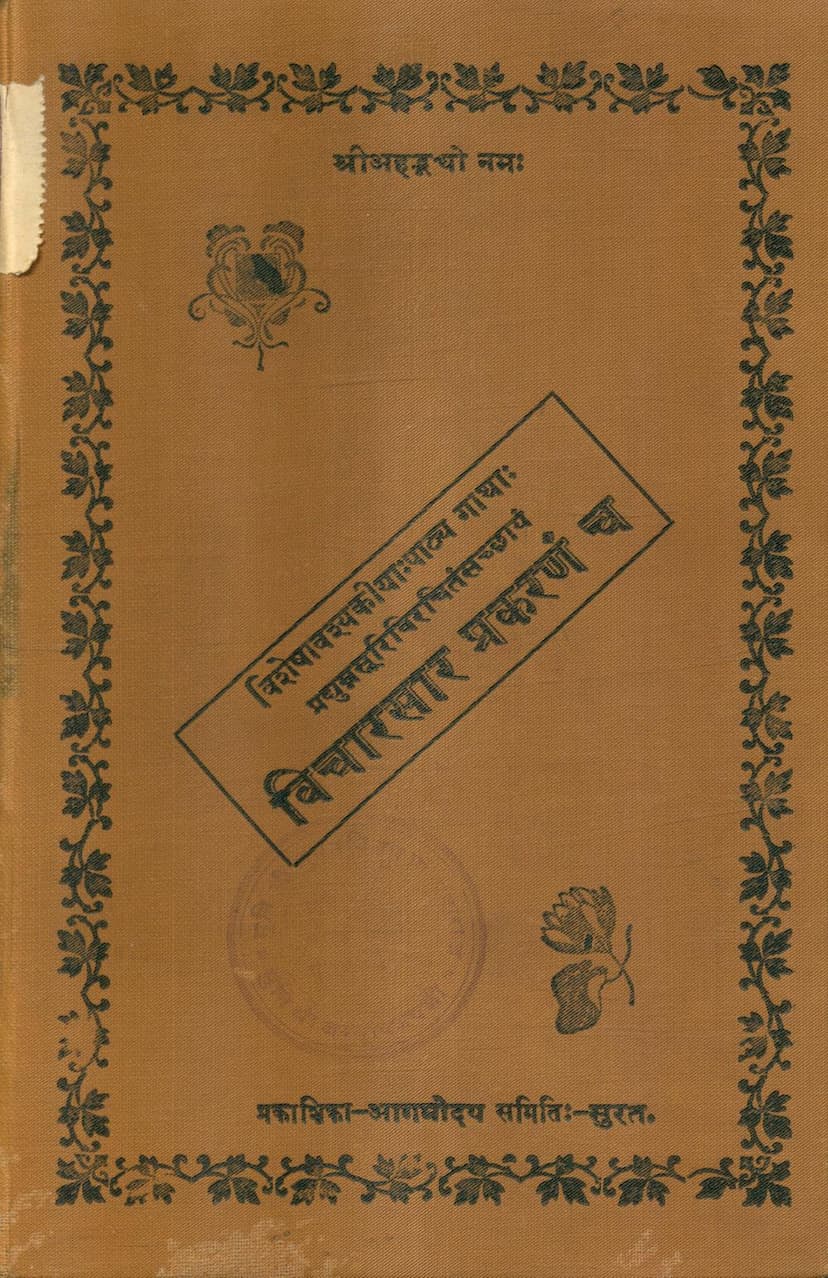Vicharsar Prakaranam Cha
Added to library: September 2, 2025

Summary
Here's a comprehensive summary of the Jain text "Vicharsar Prakaranam Cha" based on the provided pages:
Title: Vicharsar Prakaranam Cha (विचारासार प्रकरण च)
Authors: Pradyumnasuri (प्रद्युम्न सूरि), Manikyasagar (माणिक्यसागर)
Publisher: Agamoday Samiti, Surat (आगमोंदय समिति, सूरत)
Catalog Link: https://jainqq.org/explore/002348/1
Core Content and Purpose:
The text "Vicharsar Prakaranam Cha" is presented as a compilation of important verses (Gatha) from the "Visheshavashyak Bhashya" (विशेषावश्यक भाष्य). The primary purpose, as stated by Manikyasagar, is to provide accessible "Gathas" for those who are unable to study the entire voluminous "Visheshavashyak Bhashya." This compilation aims to be beneficial for a wider audience by presenting key philosophical and practical aspects of Jainism in a more digestible form.
Key Figures and Historical Context:
- Author: The main author of the "Vicharsar Prakaranam" itself is identified as Pradyumnasuri, a disciple of Shri Devaprabhasuri, who was a student of the renowned debater Shri Dharmaghoshasuri. This establishes a clear lineage within the Jain monastic tradition.
- Compiler/Commentator: Manikyasagar is credited with creating the "Chhaya" (छाया), which signifies a commentary or an explanation of the original verses.
- Reviser/Publisher: Shri Anandasagar Suri is mentioned as a prominent figure who undertook the task of revising and publishing this work, highlighting the effort to make these profound teachings accessible.
- Historical Period: The text places the author (Pradyumnasuri) in the 14th century of the Vikram era (Vikram Samvat 1979, Veer Samvat 2449, corresponding to 1923 CE). It also notes that these are ancient scholars, as they are referenced by Shri Ratnasekharsuri in his "Shraddhavidhi."
Structure and Content (based on the "Vishayanukram" - Table of Contents):
The "Vishayanukram" on pages 5-9 provides an extensive and detailed outline of the topics covered in the work. It is a remarkably comprehensive index, demonstrating the breadth of knowledge and practice discussed. Some of the major categories and specific topics include:
- Cosmology and Geography: Descriptions of the universe (Lok), various celestial bodies, continents (Bharat, Airavat, Videh), regions (Arya, Anarya), and their characteristics.
- Tirthankaras and Jinas: Detailed information about past, present, and future Tirthankaras, their birth constellations, zodiac signs, parentage, cities, lifespan, physical attributes, and distinctive marks.
- Jain Monastic Life: Rules and regulations for monks (Sadhus) and nuns (Sadhvis), their conduct, spiritual practices (Tapas), knowledge acquisition, vows, and asceticism. This includes details on fasting, dietary rules, clothing, and purification.
- Lay Discipleship (Shraddha): The conduct, vows, and qualities of lay followers (Shravakas and Shravakinis), their duties, and the lineage of prominent lay disciples.
- Jain Practices and Rituals: Discussions on temple construction, idol installation (Pratishtha), worship rituals, purification of dwellings, and the importance of virtuous conduct.
- Spiritual Development: Stages of spiritual progress, concepts of karma, liberation (Moksha), meditation, and the qualities of enlightened beings.
- Jain Philosophy and Logic: Discussions on different perspectives (Naya), the nature of reality, knowledge (Jnana), faith (Darshan), conduct (Charitra), and philosophical reasoning.
- Scriptural Categories: References to various Jain Agamas and their significance.
- Specific Ascetic Practices: Detailed explanations of different types of fasting, austerities, and purification rituals.
- Important Concepts: Discussions on concepts like Samayik (equanimity), Pratil_ekhana (cleaning of utensils/clothing), Aushadhi (medicines), etc.
- Historical Figures and Traditions: Mentions of prominent monks, Acharyas, and their contributions.
The Gathas (Verses) on Pages 10-39:
Pages 10 through 39 present the actual Gathas from the Visheshavashyak Bhashya, as compiled and commented upon. These are written in Prakrit (or a related vernacular) and include:
- Philosophical Definitions: Verses explaining key Jain concepts like names, substance (Dravya), qualities (Bhava), perception (Pratyaksha, Paroksha), and the nature of knowledge.
- Ethical Principles: Discussions on truthfulness, non-violence (Ahimsa), and the pitfalls of false beliefs.
- Karma and Liberation: Verses touching upon the workings of karma, its cessation, and the path to liberation.
- Monastic Conduct: Guidelines on daily routines, the importance of a Guru, and adherence to vows.
- Logic and Epistemology: Explanations of different modes of knowledge and logical reasoning.
- Specific Practices: Instructions and elaborations on various ritualistic and ascetic practices.
Overall Significance:
"Vicharsar Prakaranam Cha" serves as a valuable resource for Jain scholars and practitioners by:
- Making complex scriptures accessible: It democratizes access to profound Jain teachings by presenting them in a more condensed and explained format.
- Providing a systematic overview: The detailed "Vishayanukram" allows readers to navigate and understand the vast scope of Jain philosophy and practice.
- Preserving ancient Jain knowledge: It acts as a conduit for transmitting the wisdom of earlier Acharyas to subsequent generations.
- Emphasizing the practical application: The text highlights not just theoretical knowledge but also the practical aspects of Jain conduct and spiritual discipline.
In essence, this work is a testament to the Jain tradition's commitment to disseminating knowledge and guiding individuals towards spiritual upliftment and liberation.